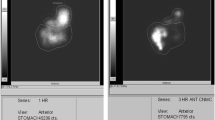Abstract
The acquisition of gastric emptying (GE) date by scintigraphy has become an important component of the evaluation of the pediatric patient for gastroesophageal reflux (GER). Delay of GE can contribute to ongoing gastric distension and hence increase propensity to reflux. Generally, only 1 h GE is determined during scintigraphy. Infants with GER have variable patterns of symptoms: some have spitting, vomiting, choking, and/or apparent life-threatening events in the immediate ostprandial period only, whereas in others symptoms persist until the time of next feeding. It is not clear whether differential rates of GE contribute towards such disparity of symptoms. We performed this prospective study to determine the correlation between GE at 1 h or 2 h, respectively, and for 2 h following a feeding in 27 infants under one year of age, who were referred for evaluation of GER. Continuos scintigraphy was performed for 2 h following a formula feeding. Gastric emptying at 1 h was calculated as percent of original dose emptied by 60 min; GE at 2 h was calculated as percent of isotope remaining in the stomach at 60 min which was emptied by 120 min. The median GE between 0 to 60 min was 36% (95% CI26.0-42.0) and median GE of the residual formula between 60 to 120 min was 45% (95% CI34.3-51.3). The correlation coefficient of GE, at 1 h with total GE over 2 h was 0.75 and of GE during the 2nd h with total GE over 2 h was 0.76. We conclude that routine determination of GE for 2 h continuously does not appear to offer clinically significant additional information.
Similar content being viewed by others
References
Hillemeier AC, Lange R, McCallum R, Seashore J, Gryboski J (1981) Delayed gastric emptying in infants with gastroesophageal reflux. J Pediatr 18: 190–193
Seibert JJ, Byrne WJ, Euler AR (1983) Gastric emptying in children: unusual patterns detected by scintigraphy. AJR 141: 49–51
Jian R (1990) Scintigraphic measurement of gastric emptying in clinical practice. Motil Clin Perspect Gastroenterol 10: 11–15
Rosen PR, Treves S (1984) The relationship of gastroesophageal reflux and gastric emptying in children: concise communication. J Nucl Med 25: 571–574
DiLorenzo E, Piepsz A, Ham H, Cadranel S (1987) Gastric emptying with gastroesophageal reflux. Arch Dis Child 62: 449–453
Tolia V, Calhoun JA, Kuhns L, Kauffmann RE (1990) Lack of correlation between extended pH monitoring and scintigraphy in the evaluation of infants with gastroesophageal reflux. J Lab Clin Med 115: 559–563
Gelfand MJ, Wagner GG (1991) Gastric emptying in infants and children: limited utility of 1 hour measurement. Radiology 178: 378–381
Tolia V, Calhoun J, Kuhns L, Kauffmann RE (1989) Randomized, prospective double-blind trial of metoclopramide and placebo for gastroesophageal reflux in infants. J Pediatr 115: 141–145
Holloway RH, Hongo M, Berger K, McCallum RW (1985) Gastric distension: a mechanism for post prandial gastroesophageal reflux. Gastroenterology 59: 779
Hangen D, Malt GS, Anderson JE, Knauer CM (1989) Marked hypergastinemia in gastric outlet obstruction. J Clin Gastroenterol 11: 442–444
Keshavarzian A, Bushnell DL, Sontag S, Yegelwel EJ, Smid K (1991) Gastric emptying in patients with severe reflux. Am J Gastroenterol 86:738–742
Miller JM (1991) Upper gastrointestinal tract evaluation with radionuclides in infants. Radiology 178: 326–327
Sutphen JL, Dillard VL (1989) Dietary caloric density and osmolality influence gastroesophageal reflux in infants. Gastroenterology 97: 601–604
Sutphen JL, Dillard VL (1988) Effect of feeding volume on gastroesophageal reflux in infants. J Pediatr Gastroenterol Nutr 7: 185–188
Billeaud C, Guillet J, Sandler B (1990) Gastric emptying in infants with/without gastroesophageal reflux according to the type of milk. Eur J Clin Nutr 44: 577–583
Hunt JN, Smith JL, Jiang CL (1985) Effect of meal volume and energy density on the gastric emptying of carbohydrates. Gastroenterology 89:1326–1330
Tolia V, Kuhns L, Lin CH (1992) Gastric emptying using 3 different formulas in infants with gastroesophageal reflux. J Pediatr Gastroenterol Nutr 15: 297–301
Author information
Authors and Affiliations
Rights and permissions
About this article
Cite this article
Tolia, V., Kuhns, L. & Kauffman, R. Correlation of gastric emptying at one and two hours following formula feeding. Pediatr Radiol 23, 26–28 (1993). https://doi.org/10.1007/BF02020216
Received:
Accepted:
Issue Date:
DOI: https://doi.org/10.1007/BF02020216




